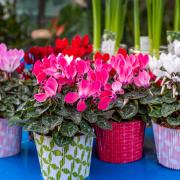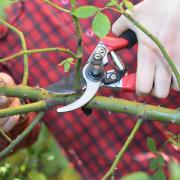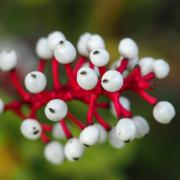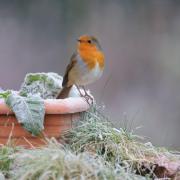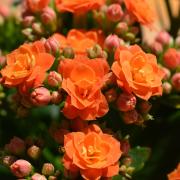While some gardeners may be thinking about putting their garden to bed at the end of summer, Gardeners’ World presenter Rachel de Thame is enjoying the beauty of dahlias and sedums, as well as other eye-catching plants as the cooler months approach.
“The whole idea of putting the garden to bed no longer really applies,” says the TV presenter and writer.
“I think we’ve all recognised that there’s still so much beauty to see in the garden later in the year and it’s better for the garden and the wildlife and pollinators that we don’t chop it all back and neaten it all off.
“I would say, embrace every aspect of the seasons and enjoy some of these incredible colours and the firework display that we get in autumn and those rare frosty days which sparkle in winter.”
De Thame’s favourites for seasonal interest include:

1. Dahlias
“I must admit that dahlias were plants I didn’t grow for ages, until about 12 years ago, when I visited a garden and was confronted by a bank of colour which was absolutely mind-blowing. I’ve become completely addicted to them ever since, because they are incredibly good-value plants.
“They begin flowering in summer and in my garden keep going until November. If you deadhead regularly, you are encouraging lots of new flowers.
“Increasingly, the breeding that’s gone into dahlias in the last few years means there has has been an explosion of different types, shapes, forms, colours and height. You’ve got everything from your blockbusters like ‘Café au Lait’ , which is big and blousy, to your singles like ‘Bishop’s Children’, which have dark-coloured foliage and come in fiery colours of orange through to red, which you can grow from seed.”

2. Alstroemeria
“Some of my friends are sniffy about them, as it reminds them of garage forecourts, but if you choose wisely there are some beautiful ones,” says de Thame.
“My favourite is ‘Indian Summer’ because the colour is so stunning. I’m drawn to dark foliage combined with a bright flower. This has dark stems and leaves, while the flowers are beautiful streaks of tangerine, gold and peach.
“It’s such good value. By midsummer you have loads of them flowering on one stem and when they start to go over, instead of chopping the spent flower stems you pull them, give them a sharp tug, and they come away at the base of the plant.
“Very quickly the plant develops new foliage and a new set of buds and flowers, which are opening now. They may produce more later, depending on the weather.
“They are as tough as old boots, I’ve had them in the ground here for five years, they are well behaved and haven’t spread all over the place. They have potential to flower into November.”

3. Hylotelephium (sedum)
“They are incredible because you have this fleshy foliage and broccoli-like flowerheads which are sometimes quite flattened. They are lovely in bud and in flower and when they go over they sort of become dried, but are still attractive and architectural.
“There are lots of different varieties but I still like the straightforward species one, Sedum spectabile. You can get sedums with dark foliage and others with a creeping habit.”
Pollinators also love them so they are extremely useful for insects which are still foraging as the weather starts to cool off.

4. Autumn and winter-flowering bulbs
“The autumn crocus (colchicums) are something you don’t expect to see as people are fixated with spring bulbs. I love the little autumn-flowering cyclamen and colchicums.
“You’ve had an amazing summer spectacle with all these incredible punchy colours with autumn-flowering perennials, but I love that as the season progresses you have these quieter moments, seeing things like autumn crocus at ground level.”
“You can have whole swathes of them in enormous gardens but even if you’ve got one tree, a flowering cherry or something like that, just cluster them around the base of that or underneath some deciduous shrubs.
“Some people grow them in pots but for me they look better naturalised. They grow through the grass as well.”
Eranthis are also fantastic, she says, producing carpets of little golden flowers in January and beyond.

5. Hellebores
“Hellebores are a must-have in my garden. Some of the early ones come out close to Christmas, and they go on quite late. And because the flowers often hold well, even after they are spent they still look attractive on the plant.
“I love them when they are really dark, almost like slate, the little edges and spots and splashes. They self-seed profusely and I leave a few to see what’s to come up.
Their classic colours are everything from white and green to pink and ruby, with nodding heads, although there’s been much breeding to adapt the blooms to become forward-facing.
“Actually, I like the dangling flowers, where you have to go in with your finger and lift it up to look inside it,” says de Thame.



